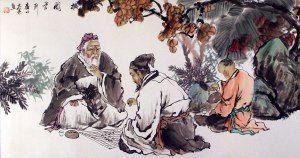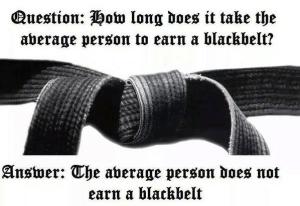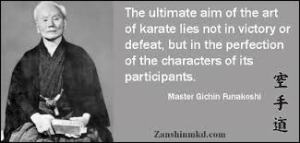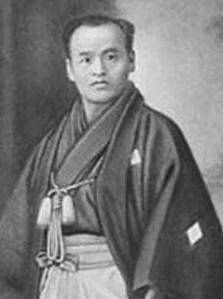The three principles of Hapkido are the underlying concepts which help us understand how to apply and implement our Martial Art. These principles are called the three principles of Hapkido, however they are very fundamental principles which are applicable to most Martial Arts.
 The first principle is Non Resistance to Force. In our Martial Arts practice we use this principle to move around obstacles and maintain our balance. This often causes our partner to loose their balance by their own intention to harm us. When someone punches us, we do not have to block force with force, we can reposition ourselves so that the punch is no longer threatening us. The principle of Non Resistance to Force is a core part of our Art, which is in some ways based on opportunity. Our style is not aggressive, however once an attack is initiated, we control and neutralise an attack very rapidly.
The first principle is Non Resistance to Force. In our Martial Arts practice we use this principle to move around obstacles and maintain our balance. This often causes our partner to loose their balance by their own intention to harm us. When someone punches us, we do not have to block force with force, we can reposition ourselves so that the punch is no longer threatening us. The principle of Non Resistance to Force is a core part of our Art, which is in some ways based on opportunity. Our style is not aggressive, however once an attack is initiated, we control and neutralise an attack very rapidly.
Bruce Lee is quoted as saying ‘in moving flow like water, respond like an echo’. This is a very poetic way of describing Non Resistance to Force. Move like water; water has the excellent property of being able to be everywhere and nowhere at the same time. Echoes – reflecting back what a partner says or does is an excellent skill for conflict resolution. Mirroring a partner’s body language can deflect angry confrontations. Reflecting back someone’s words shows you were paying attention and understood what they were saying. In both of these cases you do not give up your ideas or thoughts, you simply acknowledge your partners. This leads us in to a deeper understanding of how the first principle applies to our lives.
I believe the mental definition of this principle is about keeping calm in the face of confrontation. We often find that in times of stress we response reflexively rather than in a calm and considered manner. The idea of non resistance to force embraces the idea of ‘going with the flow’. This also helps us to understand the principle of seeking first to understand, then to be understood. When we allow the other side or the other person in a situation or a conflict to have their say, and really listen to them, then we can get a good resolution. Much as when a partner in sparring can overbalance themselves by their own attack, so can a verbal antagonist find their own resolution without us jumping in. we go with the flow and try to position ourselves side by side with our partners, rather than set ourselves up as opponents.
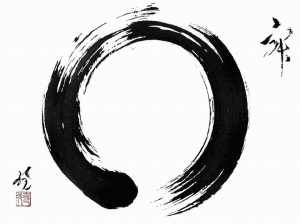 The second principle of Hapkido is Circular Motion. This is a way that we move which allows us to build up more energy and unleash greater power. It is an excellent way of adding strength to our attacks and effectiveness to our defensive positions. When you look at our Martial Art, there are circles everywhere. Even when we punch we rotate our first as we deliver the strike. Circular motion allows us to be more powerful in our strikes and more unpredictable. It is harder to predict where a circle will end up, compared to a straight line.
The second principle of Hapkido is Circular Motion. This is a way that we move which allows us to build up more energy and unleash greater power. It is an excellent way of adding strength to our attacks and effectiveness to our defensive positions. When you look at our Martial Art, there are circles everywhere. Even when we punch we rotate our first as we deliver the strike. Circular motion allows us to be more powerful in our strikes and more unpredictable. It is harder to predict where a circle will end up, compared to a straight line.
Circles are far friendlier shapes than straight lines or squares. When we think in a linear manner, we continue to think in the same way at the end of a problem or situation as we thought when we started out. When we are able to embrace the idea of circular thinking, or spiral thinking, we encompass a lot of different ideas along the way. We may still end up at the same place, but it has been a far more enlightening journey than if we had thought only in a straight line.
The final principle of Hapkido is the Water Principle. This is divided into 4 sections. The first part is to be calm and reflective. This is an important thing in a physical situation; to first be calm and think about what is happening and analyse what the correct thing to do might be. This is often enough to defuse a situation before it even has time to develop. It is also important to develop a calm attitude in the midst of fighting or other forms of conflict. There is an excellent quote from the Bhagvagad Gita which says
‘Enter into the heat of the battle and keep your heart at the lotus feet of the Lord.’
This is telling us that even when we are surrounded by noise and chaos we can still be calm and reflective. Even when we are under high pressure, stressful situations we can still keep a calm centre in the midst of all the chaos. This is the essence of being calm and reflective. It has to come from inside us or it is not there at all.
The next aspect of the Water Principle is flowing like a river. When we put our techniques together we aim to flow them together seamlessly to make a more effective attack and at the same time increase our defensive capacity. As we flow our techniques together we become a stream of moving energy, changing direction where necessary but always continuing to move. A stream is always moving in one direction though it changes course frequently. Its driving purpose is to find lower ground and it constantly moves towards this goal. Obstacles appear and the stream simply flows around them.
Another aspect of the water principle is infiltration. As water drips on a rock, eventually it either finds or creates a weakness in the rock, enabling the water to pass through, wearing away the rock over time to create cave systems and canyons. So we can continually attack in our sparring, searching for a weakness in our partner’s defence, or creating one by wearing them down. In this way, with time and perseverance we can overcome even the largest obstacles.
 The final aspect of the water principle that we will consider is concentration of force. We use this aspect of the water principle as a follow up to the other principles. Once we have discovered a weakness, flowed into a good position, when we attack, we do it with the power of a wave crashing on the beach, swamping everything in our path.
The final aspect of the water principle that we will consider is concentration of force. We use this aspect of the water principle as a follow up to the other principles. Once we have discovered a weakness, flowed into a good position, when we attack, we do it with the power of a wave crashing on the beach, swamping everything in our path.
